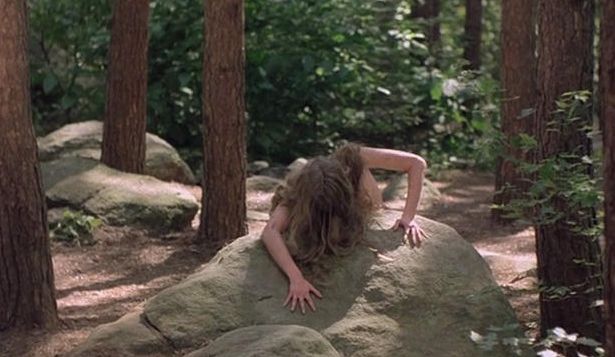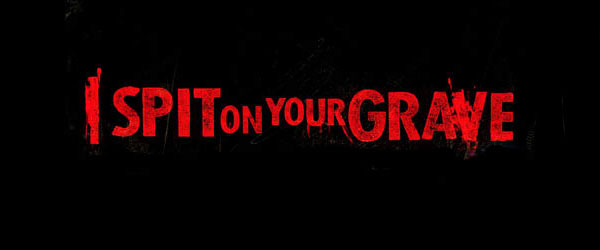Roger Ebert’s review of Meir Zarchi's 1978 film I Spit On Your Grave (aka, Day of the Woman) in 1980 created both the controversy and the reputation this film holds to this day. How does a critic do that? One, by either giving the micro-budgeted film a rave review and the film finds its audience from there. Or two, he rips it to shreds, calling it, “A vile bag of garbage.” He then goes on to tear the film to such ribbons that over the years a certain type of film-goer thinks, “Let me see that for myself.”
Guess what? Scenario two is the one that occurred. In fact, this film would never have been remade in 2010 without Ebert's eviscerating review of the original. In hindsight, he would have been better off ignoring it entirely. The problem with Ebert's review (it's available online) is that what he was really reviewing was the vile audience he saw it with, not the film. Briefly, both versions of I Spit On Your Grave tell the story of a young woman, Jennifer Hill (Camille Keaton, in the 1978 version; Sarah Butler, in the 2010 version), who rents a cottage on a river outside of very small town. She's a writer seeking privacy to write; she doesn't get it. Instead, she attracts the attention of four losers in the town who at first taunt and then rape her repeatedly. After they fail to kill her, she recovers and enacts a brutal revenge on all of them. In early February, Anchor Bay released both versions of the film, with commentary tracks and short documentaries, on DVD and Blu-ray.
 |
| Roger Ebert |
In Ebert's review of the original, he was justifiably horrified by some of the audience’s reaction as he watched. During one of the extended sexual assaults, a male audience member called out “that was a good one. That'll show her.” During the latter half, when Hill gets her vengeance, a female audience member yelled at the screen: “Cut him up, sister.” You cannot predict your audience. He could have seen the film with another audience that was disgusted by the film and said nothing, but he didn't. This audience's disturbing reaction affected his reaction.
So, what is the film like? I'm very reluctant to overpraise the 1978 version, because it really is nothing more than a poorly acted, very violent 1970s-era exploitation film, but there is more going on here than a sicko rape and then reverse revenge travesty. Director Zarchi is not much of a writer nor is a he a deep thinker, but at least you can tell that his ideas come from some place other than “oooh, isn't that a cool image” that infects the 2010 remake. Locating a lot of the action on a river, he presents the 'locals' in a manner that evokes John Boorman's Deliverance. The film's latter half revenge suggests hints (very tiny hints) of the darkest of Greek revenge tragedies (with the blood on stage instead of off). His other idea to not use music, just the surrounding landscape noises as the 'music,' is somewhat inspired. Yes, the acting is generally terrible (though you cannot fault the bravery of female lead Keaton who spends large swaths of the film completely naked), the soundtrack is muddy so it's best to keep the subtitles on to hear, if you must. But the generally lame dialogue, plus the special effects, leaves a lot to be desired. Yet this film achieves what I think Zarchi honestly intended. Based on his preferred title, Day of the Woman, he really thinks this is a feminist film. It's a stretch, but an argument can be made. The depictions of the rapes are brutal and very hard to watch. There is nothing either erotic or exciting about them. The same can be said for her various acts of revenge. Her actions are violent, relentless and disturbing. And they’re meant to be.
Also, there are two moments in the film that are actually quite affecting. One is a visual and the other is a plot moment. I Spit on Your Grave is generally badly shot, but one image is quite haunting. After the second assault, the rapists leave the abused Hill in a wood glade. The scene is shot in master only. All we see, in the middle distance, is her long, red hair and arms draped over a large, grey rock. The shot is held and held and held. It is deeply disturbing and troublingly beautiful image. The plot moment occurs after she has recovered and decided what to do. She drives into town, enters a mostly empty church, walks up to the altar and says to Christ on the cross, “please forgive me.” She then walks out to exact her revenge. Ebert thought this was a stupid moment. He's wrong. It's incredibly sad and almost moving. However, by this time in the film, I'm convinced Ebert was so traumatized by the audience's reaction he could no longer bring any real critical acumen to bear upon it.
 |
| Camille Keaton in I Spit on Your Grave (1978). |
Also, there are two moments in the film that are actually quite affecting. One is a visual and the other is a plot moment. I Spit on Your Grave is generally badly shot, but one image is quite haunting. After the second assault, the rapists leave the abused Hill in a wood glade. The scene is shot in master only. All we see, in the middle distance, is her long, red hair and arms draped over a large, grey rock. The shot is held and held and held. It is deeply disturbing and troublingly beautiful image. The plot moment occurs after she has recovered and decided what to do. She drives into town, enters a mostly empty church, walks up to the altar and says to Christ on the cross, “please forgive me.” She then walks out to exact her revenge. Ebert thought this was a stupid moment. He's wrong. It's incredibly sad and almost moving. However, by this time in the film, I'm convinced Ebert was so traumatized by the audience's reaction he could no longer bring any real critical acumen to bear upon it.
This brings me to the remake. Not surprisingly, it was released last year to generally bad reviews (including one by Ebert). A film like this is never designed for the critics. Of the two films, this is the one that could be called terrible, but not for the reason you'd think. The scenario is generally the same, but the river is abandoned for extended sexual assault sequences within the cottage. The assaults are brutal, but compared to the unsparing vision in the first, they're toned down. Her revenge, though, is far more gruesome than in the first picture. The result? It's not trying to top the original, but the torture-porn movies of the last few years such as Saw I through VI. By abandoning what made the first version disturbing, the film-makers have done something they certainly weren't intending: they made a dull movie. The set pieces where the men are killed are clearly designed, as I said above, as, “ooh, isn't that a cool image” scenes. Attached to nothing but shock, this remake flays away, trying to be controversial. However, a bigger budget, with smaller brains, does not a 'cult hit' make.
Ebert should have left well enough alone.
– David Churchill is a film critic and author of the novel The Empire of Death. You can read an excerpt here. Or go to http://www.wordplaysalon.com for more information.


No, you're wrong; the church scene was one of many load of crap attempts by Zarchi to convince us that the woman taking this revenge is "right" and that she will not recieve any consequences for it. And no, neither God nor a jury (as the cover implies) would condone what she does to these men.
ReplyDeleteThe gender dynamics are the only reason ANYONE condones it. If that were a man in the church praying for forgiveness for his plans to kill women, we'd probably have people attacking the film for implying that God hates women.
1. The woman wasn't planning to kill men; she was planning to kill rapist men. Big difference.
Delete2. The analogy of reversing genders is ignorant of the fact that rape is extremely one-sided, gender-wise.
Brother Ebert reviewed both the movie AND the audience reaction (that's why he was The Man). As far as the audience affecting his reaction, Roger Ebert wasn't a robot; it's an incredibly safe bet he would have had the same reaction to a movie as malignant as ISOYG, either alone or with an angry mob throwing tomatoes. The second-guessing in this article is off-the-chart, as in: Oh I know every motivation the late Roger Ebert ever had (OK, I could be accused of the same thing here, but I can honestly say I'm a lifelong student of RE--- almost 30 years--- who has read just about every published review he ever wrote, and therefore know that he was the most independent-thinking critic of all time, never swayed by the opinions of his highly intelligent co-host, certainly never swayed by any lesser forces). And as far as his zealous reporting backfiring--- hey, we all have to do our jobs, and some of us do them better than others (and the field of journalism is one in which consequences can unfortunately get rather messy and difficult). Note how this author suggests in the fourth paragraph that Zarchi in fact did his job well--- to which (yes I'm gonna say it) both Ebert and I would retort that his 'job' shouldn't have been done in the first place.
ReplyDeleteAmen. Well said. The soul destroying filth of the whole ISOYG series makes me ashamed to be human. Ebert easily recognized when a film was leaving the world worse off than if it had never been made.
Delete